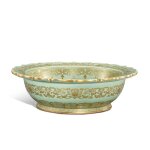Important Chinese Art
Important Chinese Art

Property from an Asian Private Collection | 亞洲私人收藏
A very rare moulded and gilt and silver-decorated celadon-glazed barbed basin, Seal mark and period of Qianlong | 清乾隆 粉青釉凸花描金銀萬壽吉慶折沿菱口盆 《大清乾隆年製》款
Auction Closed
October 9, 10:57 AM GMT
Estimate
1,800,000 - 3,800,000 HKD
Lot Details
Description
Property from an Asian Private Collection
A very rare moulded and gilt and silver-decorated celadon-glazed barbed basin,
Seal mark and period of Qianlong
亞洲私人收藏
清乾隆 粉青釉凸花描金銀萬壽吉慶折沿菱口盆
《大清乾隆年製》款
39 cm
A French private collection, acquired in the 1940s-60s or earlier.
Christie's London, 10th November 2015, lot 332.
法國私人收藏,1940-60年代或以前入藏
倫敦佳士得2015年11月10日,編號332
Subtly moulded with a ruyi rim and opulently pencilled in gilding and silver with auspicious motifs, the current basin is extremely rare and serves as a testament to the aesthetic and technological achievement in the imperial kilns in Jingdezhen in the 18th century, as well as the Qianlong Emperor’s particular reverence towards China’s glorious history. Ceramics with celadon glazes have been held in such high esteem since the beginning of their production in the Song dynasty and even within the Song dynasty alone there was evidence of a continuation of imperial taste and style from the Northern to Southern Song dynasties. By virtue of this longstanding admiration towards the celadon colour, new ways were ever developed to replicate the superb clear bluish-green tone and by the Yongzheng reign in the Qing dynasty particularly, the technique was revived and employed on smaller pieces – though very rarely coupled with relief decoration as seen on the current example. The high quality of the raw materials and technological advancements developed at the imperial kilns at Jingdezhen during the 18th century undoubtedly enabled potters to develop innovative approaches aligned with the emperors’ preferences, and to combine contemporary ruyi motifs with archaic themes, such as the use of silver and gilding to imitate earlier gold and silver-inlaid bronzes.
The carefully planned arrangement of motifs, opulently detailed in gilding and silver, however, is far from one of mere aesthetic value – the repeated use of the ruyi motif, as well as the combination of auspicious emblems are a response to the Emperor’s infatuation with portents of good fortunes. The central design of a shou medallion on the interior, combined with the friezes of bats suspending wan symbols and chimes, forms the wish for ‘boundless longevity and happiness as high as the sky’.
It is extremely rare to find a Qianlong gilt and silver-decorated basin and no identical example appears to be recorded. See an imperial inscribed wall vase, and a pair of vases, similarly detailed in gilding with ruyi and archaistic motifs, sold in these rooms, 2nd April 2019, lot 15, from the Tianminlou collection and 7th April 2010, lot 1803A respectively.
